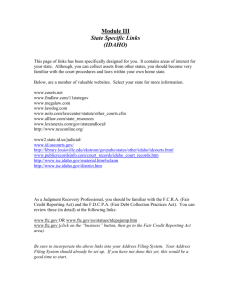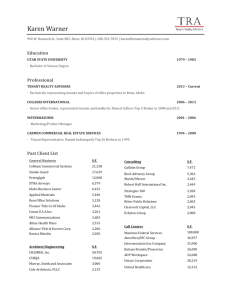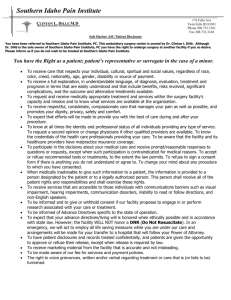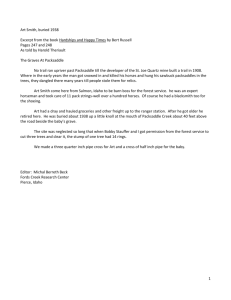Idaho State Model of Liquor Management
advertisement
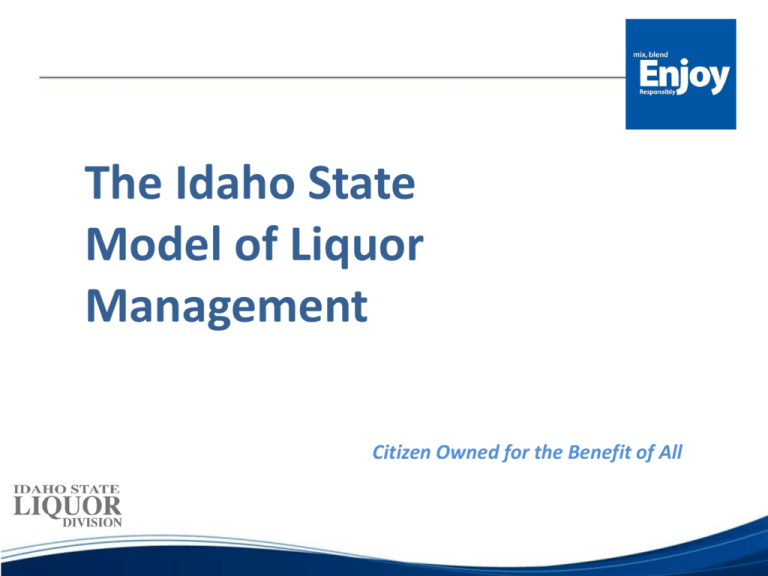
The Idaho State Model of Liquor Management Citizen Owned for the Benefit of All MISSION The mission of the Idaho State Liquor Division is to provide control over the importation, distribution, sale, and consumption of distilled spirits; curtail intemperate use of beverage alcohol; and responsibly optimize the net revenues to the citizens of Idaho. VISION The vision of the Idaho State Liquor Division is to be the most respected and highest performing purveyor of distilled spirits in the USA. Overview • 66 State-run retail stores, 98 contract stores • Full-service distribution center receives and ships one million cases annually • $153,600,000 in Sales in FY2012 • Employ 350 people state-wide • $63,100,000 distributed from FY2012 operations to Cities, Counties, Substance Abuse Treatment, & General Fund in FY2012 Idaho Statute: Title 23 – Chapter 4 • 2% surcharge on all sales goes to drug and family courts • Amount of remaining distribution is determined based on available cash and working capital needs: – In FY2012, 46% to State: • $5.65 million to state fixed-fund accounts • Remainder to general fund – In FY2012, 54% to Cities & Counties • 60% allocated to cities based on sales (90% to cities with liquor stores, 10% to cities without liquor stores) • 40% allocated to counties based on sales Control States Control States x A History Lesson • The 18th Amendment established Prohibition in the U.S. in 1920. • In 1933, the 21st Amendment repealed the 18th Amendment and ended Prohibition. • Control over beverage alcohol distribution granted to the states. All states have some form of control. 18 States, including Idaho, chose a system of greater state government involvement. About Control Systems • Nationwide, 18 jurisdictions utilize a control model • Control states average nearly 20% less consumption per adult than open states. – 1.9 gallons/capita in Idaho (skewed by Washington Sales) – 1.8 gallons/capita in all control states – 2.2 gallons/capita in open states • Idaho earns $60/gallon in revenue, while control states average $65/gallon. • Open states earn $34/gallon, but private sector profit margin increases retail price. Source: Distilled Spirits Council of America (DISCUS) The Control State Model - Benefits • • • • • • Lower per capita consumption Fewer alcohol related deaths & lost work days Safer roadways & lower crime Better selection for consumers & licensees Bailment inventory (vendor owned) Predictable revenue for local jurisdictions and lower taxes for Idaho residents Source: National Alcohol Beverage Control Association & Alcohol Justice The Control System – Why it Works • Fewer (but conveniently located) retail outlets offering spirits • Limited (but convenient) store hours • Uniform, fair, supplier-based pricing • All revenue generated remains in Idaho • ISLD does not advertise • Improved compliance vs. private sector Source: National Alcohol Beverage Control Association & Alcohol Justice Per capita Consumption Spirits Wine Beer Control States Idaho 1.80 1.90 2.66 2.55 31.01 30.40 License States 2.15 3.45 30.47 Source: Alcohol Research Group (ARG) Outlet Density Outlets Per 100,000 Residents* Control States Idaho 14.00 9.00 License States 30.00 *resident population aged 15 and older Source: Alcohol Research Group (ARG) Outlet Density Quality & Quantity The Facts Product Selection Idaho State Liquor Division Stores carry, on average, 1,200 SKUs compared to an open or license state store average of 500 SKUs --------------------------------------------------------------------------------------------------------------------------------------------------------------------------------------------------------------------------------------- Efficient Operation Sales/FT Employee = ISLD average of $709,000 vs. Starbuck’s average of $58,500. (Starbuck’s Annual Report 2011) --------------------------------------------------------------------------------------------------------------------------------------------------------------------------------------------------------------------------------------- Advantages for the Citizens We pay no federal corporate income taxes. Bailment inventory, unique to state-run operation, keeps inventory carrying costs low. The People’s Business • Distributions are a result of standard wholesale and retail mark-ups that would exist regardless of who distributed and sold distilled spirits. • ISLD utilizes a private, Idaho-owned transportation company • ISLD leases space from the private sector for our 66 retail outlets and contracts with 98 private business owners in smaller communities • Limited but convenient outlet density leads to lower, responsible consumption • Our profits stay in Idaho for the benefit of Gem State citizens • Over $600,000,000 will be distributed to all Idahoans over the next decade • Washington State: An experiment in our own backyard Impact of Washington I-1183 • Costco’s $22 million Initiative 1183 dismantled (“privatized”) Washington’s state-run liquor enterprise effective June 1, 2012. • Outlet density offering spirits increased from 328 outlets to 1,800. • Grocers and big box Retailers (>10,000 sq. ft.) were the main beneficiaries to the detriment of others. • State remains whole on revenues. No change to taxes Did NOT get gov’t out of the business • With addition of distributor & retailer mark-up Higher Prices Unhappy Consumers Potential Impact of Eliminating State Distribution of Alcoholic Liquor • Decreased revenue to counties and municipalities • May result in new taxes on non-spirits consumers • Increased health and safety risks • Reduced effectiveness in prevention of underage drinking • Increased costs to spirits consumers at retail • Increased costs to all patrons including non-drinkers in restaurants who serve liquor • May lead to negative economic pressure on small, local business by making it difficult to compete against national retailers • May result in increased unemployment – trickle down effect Potential Impact of Eliminating State Distribution of Alcoholic Liquor When Idaho State Liquor Division’s Net Income is $50MM, then $50MM is distributed back to Idaho state, cities, and counties. If private sector net income is $50MM, presumably, - $15MM is sent to IRS as federal income tax - Remaining $35MM heads out of state for distribution: • • • • Bentonville, Arkansas Cincinnati, Ohio Issaquah, Washington Minneapolis, Minnesota What to Do Understand the regulatory system and why it exists What to Do Remember all citizens, not just consumers. Abstainers 35% Regular Drinkers 51% Source: Health Statistics for US Adults: National Health Interview Survey 2010 Infrequent Drinkers 14% Closing Thoughts 98% of the net proceeds are generated from the normal wholesale and retail markup that would exist regardless of what system was in place. They keep other taxes low and come from the willing not the coerced. The structure in Idaho has been in place for over 75 years and is efficient, convenient, continually updated, and a benefit for all Idahoans. Closing Thoughts Liberalizing the system will result in increased taxes(1), increased prices to consumers(2), increased outlet density(3), and increased risk to public health and safety(4). Source: as indicated Sources: • (1) – Increased Taxes • Washington Liquor Control Board (WLCB): - $3.77/liter bottle tax and 20.5% liquor sales tax, both applied at retail checkout - 10% fee to distributors; 17% fee to retailers • (2) – Increased Prices to Consumers (WA State results from I-1183) • Reuters, June 2012: - 10%-30% or more depending on brand • (3) – Increased Outlet Density (WA State results from I-1183) • Washington Liquor Control Board (WLCB): - 500% • (4) – Increased Risk to Public Health and Safety • Published in the American Journal of Preventive Medicine April 2012 (CDC – Centers for Disease Control and Prevention) - Effects of Alcohol Retail Privatization on Excessive Alcohol Consumption and Related Harms THANK YOU! catie.wiseman@liquor.idaho.gov
